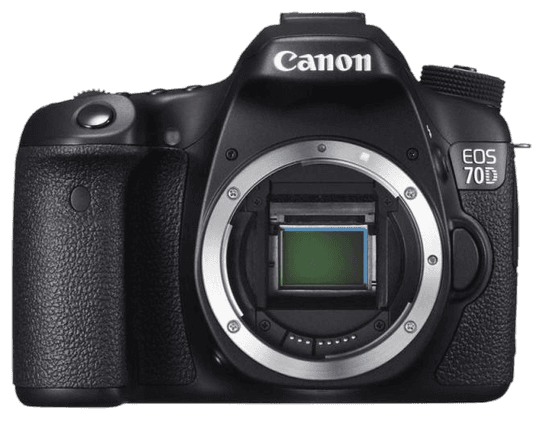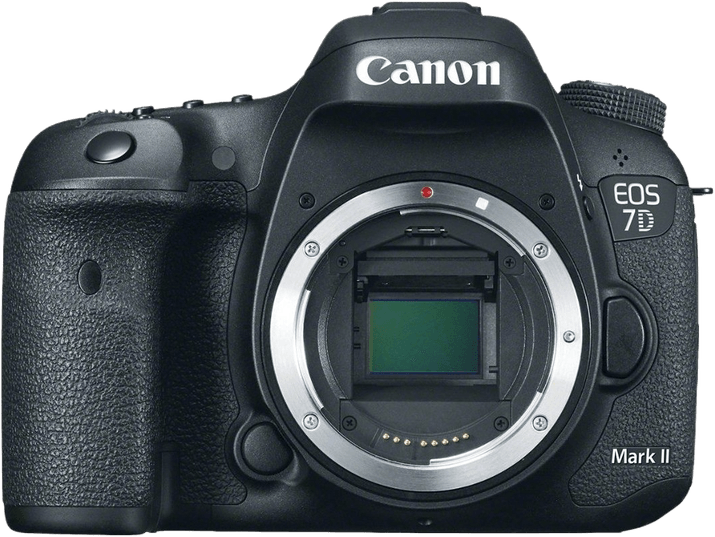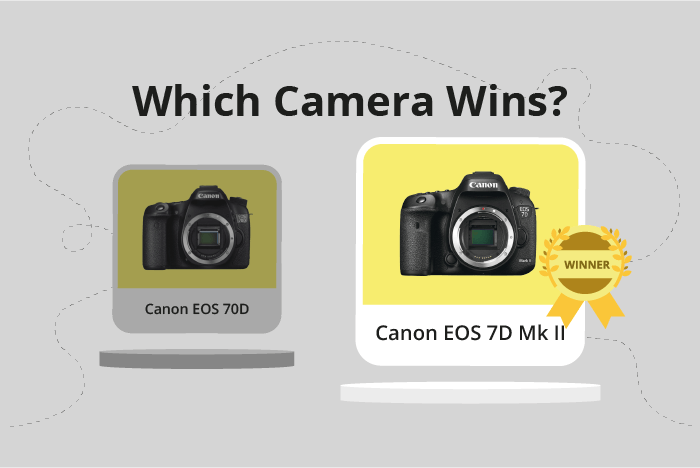Canon EOS 70D vs EOS 7D Mark II Comparison
Canon EOS 70D

Canon EOS 7D Mark II

The Canon EOS 70D and Canon EOS 7D Mark II are both DSLR cameras with an equal score of 60/100. Announced in 2013 and 2014 respectively, these cameras share some specifications, such as camera type and launch prices of $1199 and $1800. The 70D measures 139 x 104 x 79mm and weighs 755g, while the 7D Mark II is slightly larger at 149 x 112 x 78mm and heavier at 910g.
The 7D Mark II has an advantage in its release year, being a newer model with updated features. However, the 70D offers a lower price for similar performance. In terms of size and weight, the 70D is more compact and lighter, making it more convenient for travel and daily use.
Considering these factors, the Canon EOS 70D is a better choice for those seeking a more affordable and portable camera, while the Canon EOS 7D Mark II may appeal to those seeking a newer model with potentially improved features.
Canon EOS 70D vs EOS 7D Mark II Overview and Optics
The Canon EOS 7D Mark II outperforms the Canon EOS 70D in optics with a score of 61/100 compared to the 70D’s 58/100. Both cameras share several specifications, including 20.2 megapixels, CMOS sensor type, APS-C sensor size, Canon EF-S lens mount, and no image stabilization.
The 7D Mark II’s superior performance is due to its faster shooting speed of 10 frames per second (fps), compared to the 70D’s 7 fps. This difference allows the 7D Mark II to capture fast-moving subjects more effectively. Additionally, the 7D Mark II has a higher DXOMARK sensor score of 70, compared to the 70D’s 68, indicating better overall image quality. The Dual Digic 6 processor in the 7D Mark II also contributes to its improved performance, offering faster processing compared to the 70D’s Digic 5+ processor.
The Canon EOS 70D, despite its lower score, still has advantages. It is a more affordable option compared to the 7D Mark II, making it a suitable choice for budget-conscious photographers who do not require the faster shooting speed or the slightly better image quality offered by the 7D Mark II.
When considering the optics of these two cameras, the Canon EOS 7D Mark II is the clear winner due to its faster shooting speed, higher DXOMARK sensor score, and more advanced processor. However, the Canon EOS 70D remains a viable option for those on a budget who can compromise on some performance aspects.
Canon EOS 70D vs EOS 7D Mark II Video Performance
The Canon EOS 7D Mark II outperforms the Canon EOS 70D in video capabilities, with a video score of 56/100 compared to the 70D’s 43/100. Both cameras share common specifications, such as Full HD video resolution and maximum video dimensions of 1920 x 1080. Neither camera has built-in time-lapse functionality.
The 7D Mark II surpasses the 70D with its higher maximum video frame rate of 60fps, compared to the 70D’s 30fps. This increased frame rate allows for smoother video playback and greater flexibility in post-production, such as slow-motion effects. The higher video score of the 7D Mark II reflects its superior performance in this aspect.
While the 70D falls short in video frame rate, it is still a capable camera for video recording with its Full HD resolution and 1920 x 1080 video dimensions. However, the lower video score indicates that the 70D does not offer the same level of performance as the 7D Mark II.
Taking into account the differences in video capabilities, the Canon EOS 7D Mark II proves to be the better choice for those seeking higher quality video performance. The increased frame rate gives it an edge over the 70D, making it more suitable for users who prioritize video recording. On the other hand, the Canon EOS 70D remains a viable option for those who require Full HD resolution but do not need the advanced video features offered by the 7D Mark II.
Canon EOS 70D vs EOS 7D Mark II Features and Benefits
The Canon EOS 70D outperforms the Canon EOS 7D Mark II in features, with a score of 70/100 compared to 57/100. Both cameras share some specifications, such as a 3-inch screen size, 1,040,000-dot screen resolution, WiFi connectivity, and lack of Bluetooth.
The winning camera, the Canon EOS 70D, has two major advantages over its competitor. The first advantage is the presence of a touchscreen, which simplifies the camera’s operation and makes it more user-friendly. The second advantage is the inclusion of a flip screen, which allows for greater flexibility when shooting at different angles and positions.
On the other hand, the Canon EOS 7D Mark II has one significant advantage over the 70D: built-in GPS. This feature enables geotagging of images, which can be useful for photographers who want to track their shooting locations or later organize their photos based on location.
In terms of features, the Canon EOS 70D is the better camera due to its touchscreen and flip screen, which enhance user experience and increase shooting flexibility. The Canon EOS 7D Mark II, however, is still a strong contender for photographers who prioritize GPS functionality. Both cameras offer excellent screen size and resolution, as well as WiFi connectivity, making them suitable options for various photography needs.
Canon EOS 70D vs EOS 7D Mark II Storage and Battery
The Canon EOS 7D Mark II outperforms the Canon EOS 70D in storage and battery with a score of 65/100 compared to the 70D’s 37/100. Both cameras share similarities in their specifications, such as accepting SD, SDHC, and SDXC memory cards, utilizing the same battery type (LP-E6), and lacking USB charging capabilities.
The 7D Mark II excels with its dual memory card slots, allowing for more storage options and the added convenience of using both SD and Compact Flash cards. However, the 70D has a longer battery life, providing 920 shots per charge compared to the 7D Mark II’s 670 shots.
Despite the 70D’s advantage in battery life, the 7D Mark II’s superior storage capabilities make it a more versatile and convenient choice for photographers. The 70D’s longer battery life may be beneficial for specific situations, but the 7D Mark II’s overall performance in storage and battery remains superior.
Canon EOS 70D vs EOS 7D Mark II – Our Verdict
Are you still undecided about which camera is right for you? Have a look at these popular comparisons that feature the Canon EOS 70D or the Canon EOS 7D Mark II:

